Cancer, the killer disease, has emerged globally as one of the worst enemies of humanity in recent times. So much so that most of the western world now refers to its effort to fight the disease as a ‘war on cancer’. While the developed world has managed to curb its cancer-related deaths, India has now emerged as the third-largest ‘cancer capital’ of the world with around 700,000 annual deaths and huge deficiencies in terms of care infrastructure. India’s key issues are accessibility and affordability; however, improving diagnosis and newer treatment modalities coupled with affordable generic drug offerings have provided a ray of hope for cancer patients. Even so, in the prevailing situation, there is a wide demand-supply gap in the available cancer care and the ever-rising cancer incidence in the country — this offers up a huge business opportunity for drug manufacturers as well as healthcare service providers. Besides the opportunity in India, for domestic pharma companies, the scope of exporting oncology drugs to advanced markets led by generalisation and to emerging markets is tremendous. Within cancer drugs, the increasing dominance of biologic/targeted therapy should benefit Indian peers such as Dr Reddy’s Laboratories and Biocon.
Cancer is a painful subject. It is painful to the people who have it and it is painful for their loved ones. It is a killer disease. On any given day, if you walk through Tata Memorial Hospital,India’s pioneer institute of cancer treatment, you will see a familiar scene — a crowded patient poolwaiting for their turn to have a consultation with the oncologists, who have an almost god-like status at least in the eyes of the waiting patients. Their struggle for survival, the pain in the eyes of the loved ones accompanying them — all these scenes will make even the most hardened heart pause and reflect on the cold indifference of this disease and the almost near-precision with which it is taking human lives.
It is easy to see why oncologist have an almost supernatural status amongst cancer patients and their loved ones – industry data suggests there are only about 1,000 trained oncologists in India for 1.8mn cancer patients— so the ratio of oncologists to cancer patients is about 1:1,800— these statistics are just mindboggling.
Cancer is not just physically and emotionally painful. It is also financially draining. The burden of the huge unplanned expenditure that cancer entails due to the pricey nature of its treatment coupled with minimal hope of being permanently cured (due to high mortality rates) makes it a truly dreaded and dreadful disease. What is probably most tragic is the premature loss of many years of healthy life. Apart from the highest mortality nature of the disease, cancer’s rapid progressionin the afflicted person is truly horrifying.
Cancerhas become one of the biggest threats to human beings globally. Every year, 8.2mn people die of the disease and 14.2mn people are diagnosed with it — this implies an incidence of 20 people per 100,000 annually. Whether it is because of rising awareness or because of rising incidence, cancer is not just a vague notion anymore — it’s getting too close for comfort. Ask anybody around you — chances are they know of somebody close who has died of cancer or is fighting the disease at the moment.
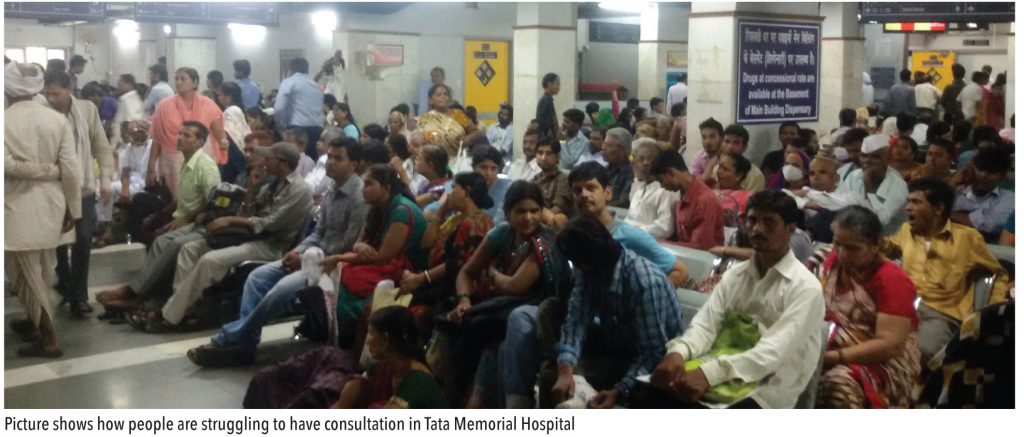
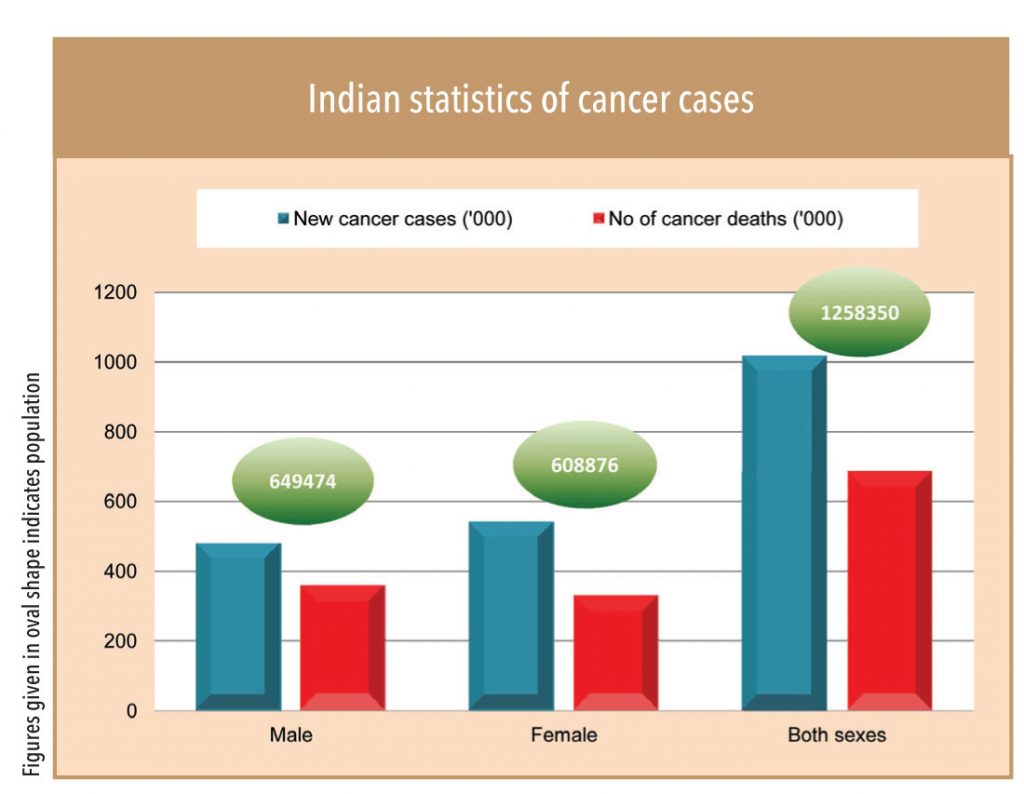
In India, it has now emerged as one of the leading causes of deaths. The International Agency for Research on Cancer estimates that cancer-led deaths in India havemultipliedfrom 157,168 in 2000 to about 682,800 people in 2012 — representing about 8% of all estimatedglobal cancer deaths and about 6% of all deaths in India. The prevalence of cancer in India is estimated to be around 2.5mn, with about 1.02 million new cases in a year.
Cancer statistics pertaining to the Indian population suggest that females are more prone to cancer than males— female cancer cases account for about 53% of the total reported ones. Among them, cancer of the breast is the most common and accounts for 27% followed by cancer of the cervix (23%), colerectum (5%), ovary (5%) and mouth (4%).
Among males, mouth cancer is the most predominant constituting 18% of the total cancers followed by lung (11%), stomach (9%), colorectal (8%) and oesophagus (6%). Overall, the incidence of breast and cervical cancer are highest amongst the Indian population followed by mouth cancer, lung cancer, and colorectal cancer.
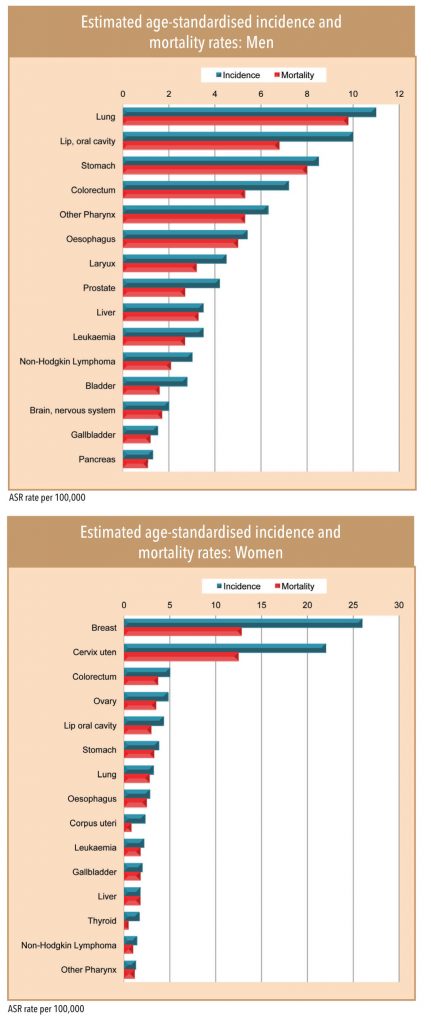
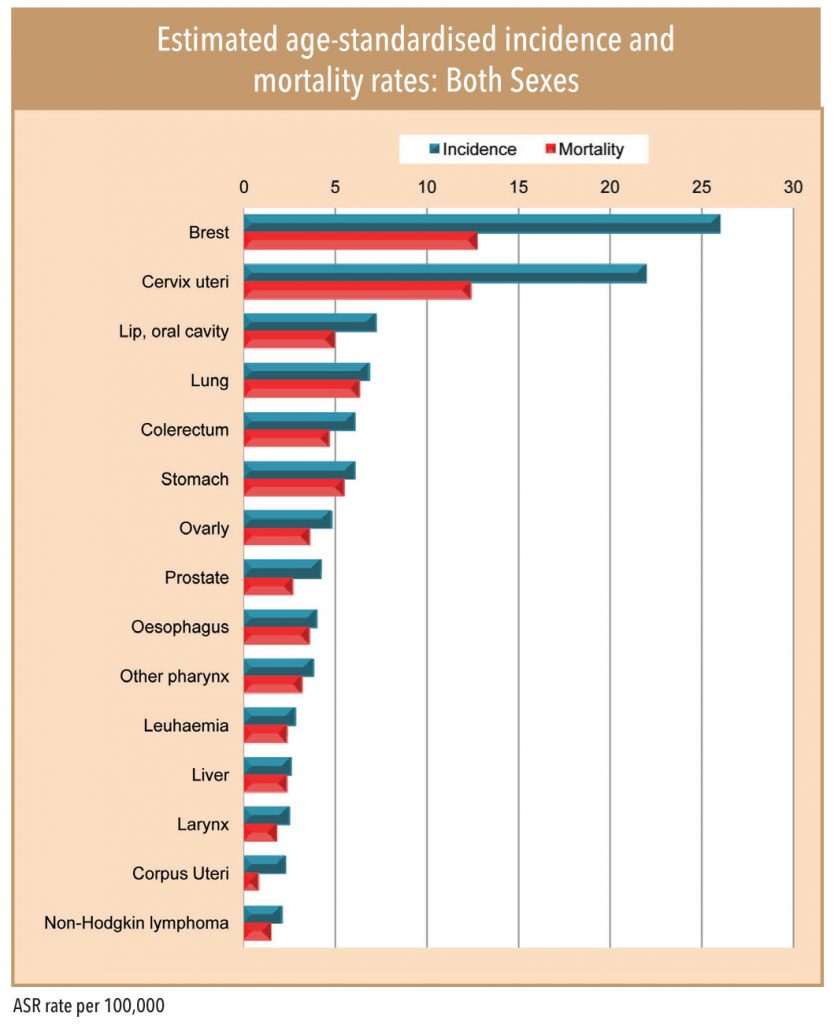
Cancer has taken India in its tight grip in recent years. Though the incidence rate in India is lower at 80 patients per 100,000 vs. 125-150 patients per 100,000 in western countries, the absolute numbers of cases in India are higher due to its large population. Also, the incidence rate could be artificially lower due to a high incidence of under-reporting or misdiagnosis.
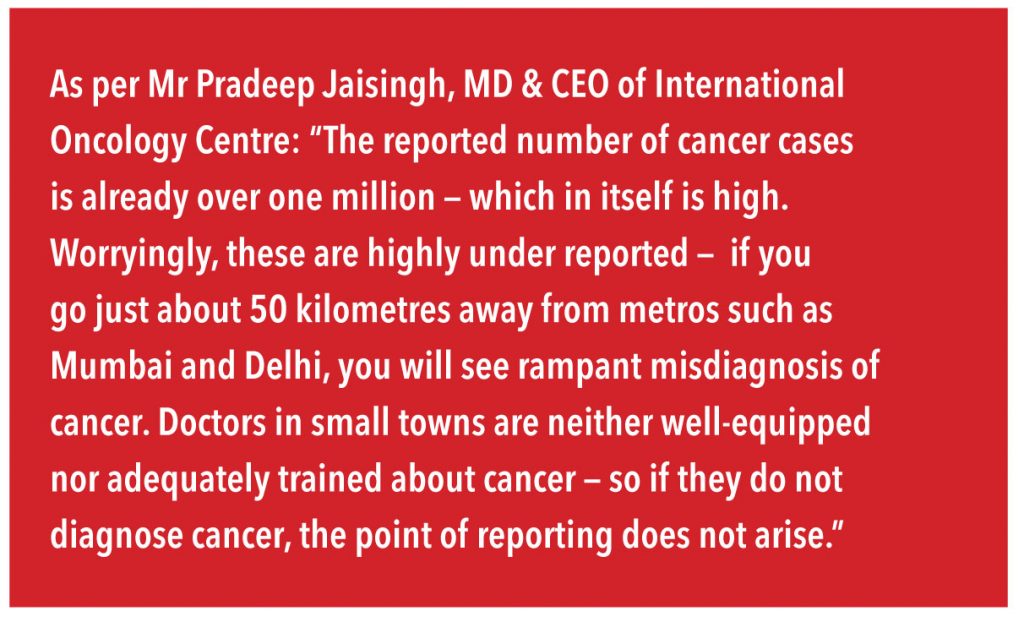
What is a definite cause for concern is that younger Indians are getting cancer — statistics suggest that 80% of cases in India occur before 65 years of age —around 15% of cases occur at early ages (before 35). In the developed world, it is believed to be an old person’s disease – but not in India. The saddest fact pertains to children though — about 160,000 children around the world are diagnosed with cancer every year; out of these 25% are in India, says Dr. Brijesh Arora, a paediatric oncologist.
So the answer to the question ‘what has caused India to fall in the tight grip of the killer disease?’ is not an easy one to answer. The increased incidence of cancer in India can be broadly attributed to urbanisation, industrialisation, lifestyle changes, and population growth. However, for India specifically,improper diet is one of the main causes of cancer prevalence. About 70% colorectal cancer cases are believed to be due to imbalanced diet.

Similarly, improper lifestyle with poor dietary habits has been the key factor for the prevalence of breast and cervical cancers in the female population in Indian cities and metros. Overall, the consumption of tobacco (smoking, chewing, snuffing) is the leading cause of cancer in India. Data points suggest that tobacco is responsible for 65-85% cancer incidences amongst Indian population. The various cancers produced by the use of tobacco are of oral cavity, pharynx, oesophagus, larynx, lungs and urinary bladder.
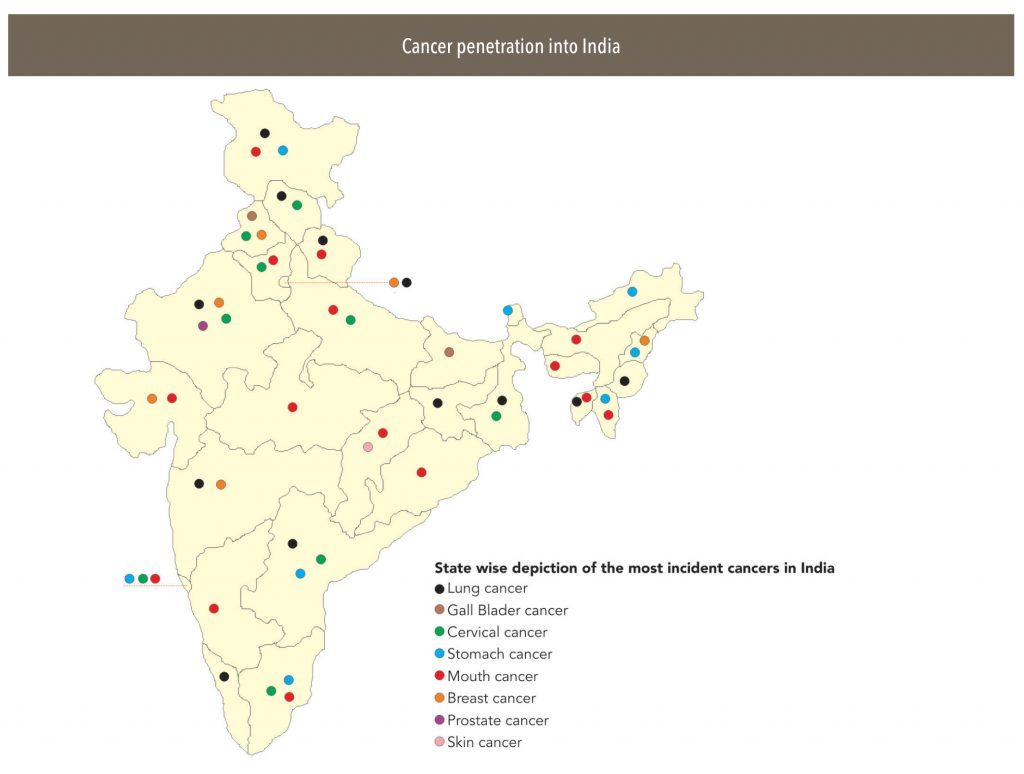
While, cigarette/hookah/bidismoking is the main cause of lung cancer in Jammu and Kashmir, Himachal Pradesh, Uttarakhand, Manipur, Andhra Pradesh, Tripura, and some parts of Sikkim, the chewing of tobacco in various forms (including pan masala, zarda, opium, bhang) and beetle leaves/nuts is the key reason for oral cancer in Orissa, Madhya Pradesh, Uttar Pradesh, and Rajasthan.
Alcohol consumption has been one of the major causes of colorectal cancer across the world and India is not excused. It also causes cancers of the upper respiratory and digestive tracts, including oral cavity, hypo pharynx, larynx and oesophagus as well as liver, pancreas, mouth, and breast.
Few other key causes of cancer in India are – excessive use of fertilizers and pesticides (that raise the risk of leukaemia and lymphoma and brain tumours), environmental/air pollution (responsible for high prevalence of lung cancers in Delhi, Kolkata), and radiations from radioactive compounds/ultraviolet/nuclear testing (leading to cancers of the skin, digestive system, liver and kidney). More than anything, it is the lack of awareness, limited access to cancer care-delivery systems, late/improper diagnosis, and the exorbitantly high treatment cost that is causing the increasing cancer deaths in India.
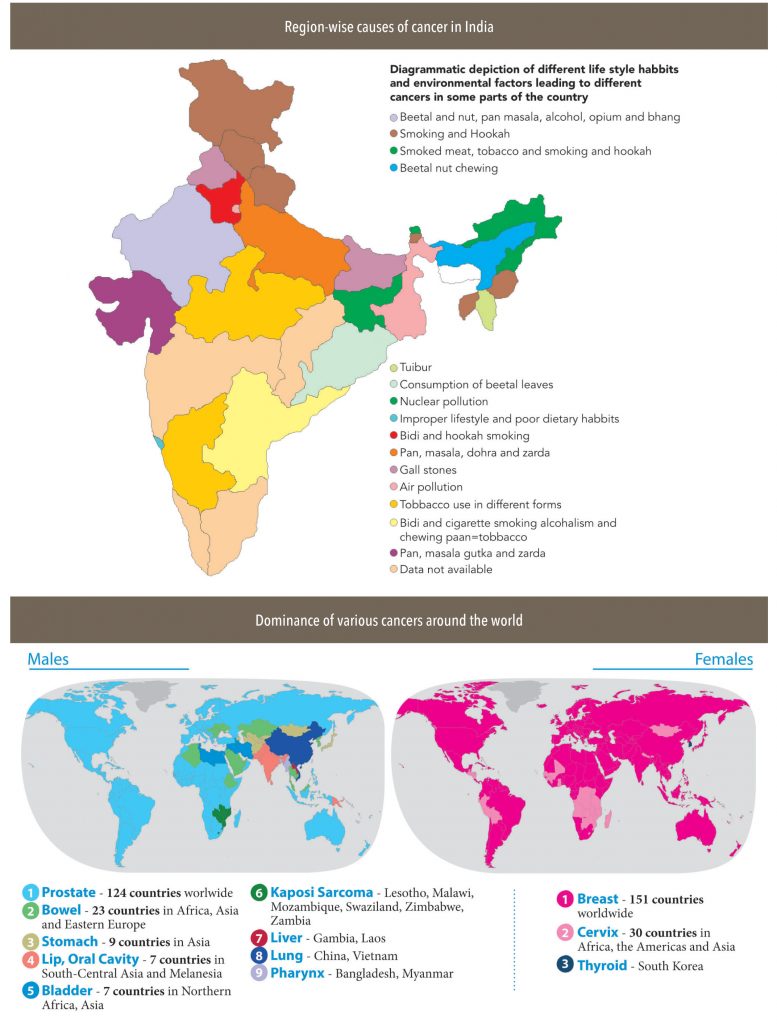
Subscribe to enjoy uninterrupted access